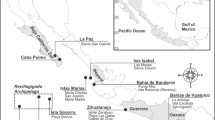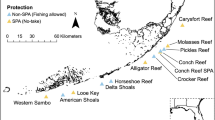Abstract
A HEAVY mortality broke out among the commercial species of sponge (Wool, Velvet, Grass, Reef, Yellow and Hardhead) on the natural banks in the waters of the Bahama Islands early in December 1938. The mortality was recorded earliest among the eastern islands of the Colony and spread rapidly westwards, until by the end of February 1939 there remained no sponge-bearing bank unaffected in the Colony. It is reported to have spread to the north coast of Cuba in February and Key West, Florida, in March. The mortality rate in most of the areas affected in the Bahamas ishigh (70–95 per cent).
This is a preview of subscription content, access via your institution
Access options
Subscribe to this journal
Receive 51 print issues and online access
$199.00 per year
only $3.90 per issue
Buy this article
- Purchase on Springer Link
- Instant access to full article PDF
Prices may be subject to local taxes which are calculated during checkout
Similar content being viewed by others
References
"Papers from the Tortugas Laboratory", 5, 7–45 (1914).
Author information
Authors and Affiliations
Rights and permissions
About this article
Cite this article
GALTSOFF, P., BROWN, H., SMITH, C. et al. Sponge Mortality in the Bahamas. Nature 143, 807–808 (1939). https://doi.org/10.1038/143807a0
Issue Date:
DOI: https://doi.org/10.1038/143807a0
This article is cited by
-
Brown Rot Syndrome and Changes in the Bacterial Сommunity of the Baikal Sponge Lubomirskia baicalensis
Microbial Ecology (2018)
-
Trade-Offs in Defensive Metabolite Production But Not Ecological Function in Healthy and Diseased Sponges
Journal of Chemical Ecology (2012)
-
Recurrent disease outbreaks in corneous demosponges of the genus Ircinia: epidemic incidence and defense mechanisms
Marine Biology (2010)
-
Sponge Mortality at British Honduras
Nature (1939)
-
Bakterien- und Pilzbefunde sowie pathologische und Fäulnisvorgänge in Meeres- und Süsswasserschwämmen
Zeitschrift für Parasitenkunde (1939)
Comments
By submitting a comment you agree to abide by our Terms and Community Guidelines. If you find something abusive or that does not comply with our terms or guidelines please flag it as inappropriate.



